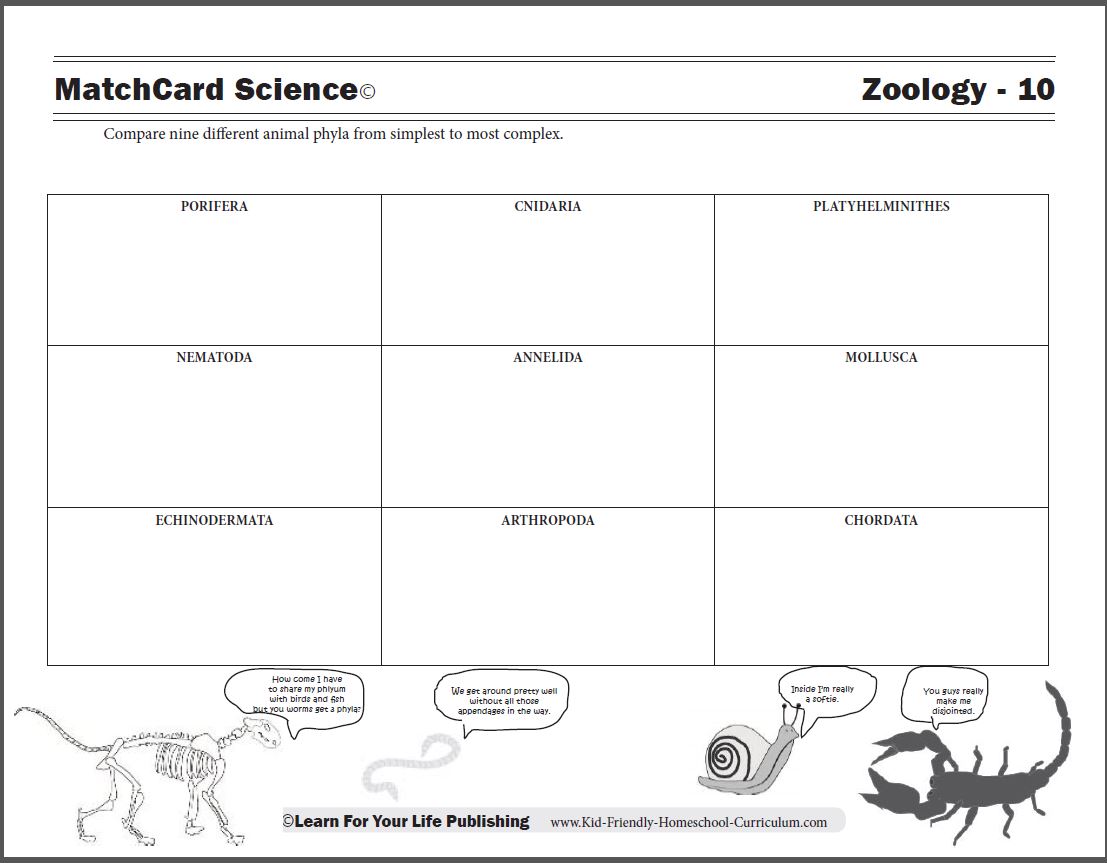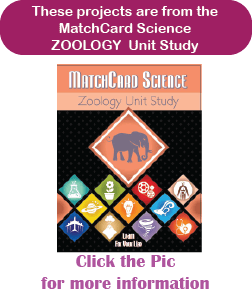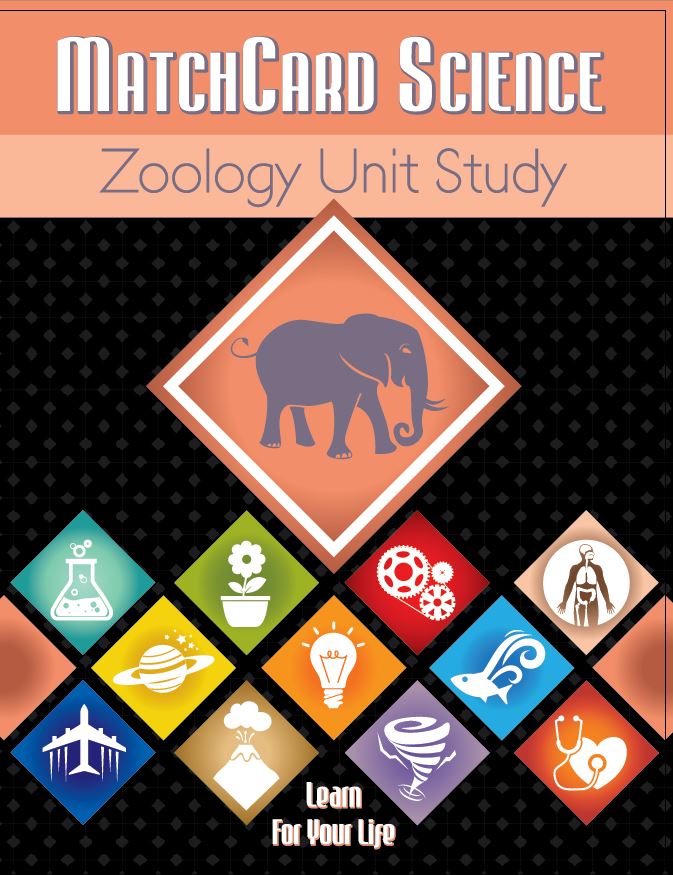

Students use the animal phyla chart to match characteristics of
the nine most common phyla to the description.
Free Download Below



Objective: Compare nine different animal phyla from simplest to most complex..
MatchCard: Download below.
MatchCard Information Pieces define and describe the following phyla: porifera, cnidaria, platyheminithes, nematoda, annelida, mollusca, echinodermata, arthropoda, chordata..
This is MatchCard #10 of the Zoology Unit Study. Find more information on MatchCard Science below.
In MatchCard 8, students learned the world of living organisms was broken into two major (and several minor) kingdoms. They traced the kingdom, phylum, class, order, family, genus, and species of dogs as they learned how the scientific classification of living things. This is a good time to review this lesson before learning more details of the animal kingdom.
Before showing students the worksheet with the nine most common animal phyla, play a guessing game with your student(s). This might be done over lunch-time, during a car ride, or other activity that may take 15 or 20 minutes.
As a fun incentive, you might offer to pay a quarter for each animal phyla they can list (without looking any up.) The majority of the animals they list, will be in the chordata phylum.
For simplicity, if they name an animal, such as jellyfish which is in the cnidaria phylum, I count that. Go ahead and tell them the scientific name. But if they guess any other animals in that phylum, tell them the name but they don't get further credit.
And just to get it straight, phyla is the plural for phylum.
Tell the student(s) how many phyla they were able to name. Show them the student copy of the animal phyla chart and where the animals they named would fit.
Give them a moment to look at the other phyla. Are any familiar?
Tell them they will learn about the most common nine phyla. More than 30 animal phyla have been identified, but these nine have more than 10,000 species in each. Some of the others may have less than ten.
This is one of the simplest of the animal phyla. The porifera are multi-celled sea animals whose cells are all alike. There is no cellular differentiation.
The word "porifera" means "pores." Basically, it is a sac of cells with pores. They have no distinct organs.
These sea animals stay attached to a rock or the bottom of the sea.
SPONGES are the best known organisms in the porifera phylum.
Look at a synthetic kitchen sponge. This writer remembers the day when people used real sponges in their kitchen. They were all the same color. Which would you prefer to use?
Cnidaria are a little more complex than the porifera. They are composed of two layers of cells that form a hollow sac and has a single opening for food to enter and waste to leave.
Like the porifera, they have no organs. However, there cells have formed a distinct double layer, instead of just existing as a conglomeration of cells.
CORAL, HYDRA and JELLYFISH are examples of the cnidaria.
These are the FLAT WORMS. They consist of a tube with flat bottom.
All the worms have Bilateral Symmetry. The symmetry demonstrates increasing complexity of cellular structures.
The platyhelminithes have organs and simple systems. They can grown new body parts to reproduce.
ROUND WORMS make up the nematoda phylum. Their body consists of a simple cylinder shape with bilateral symmetry.
It also has a few organs and simple systems.
They reproduce by laying eggs.
The annelida are the most complex of the worms.
They have segmented bodies with the cylinder divided into ringed sections. Like the other worms, they have bilateral symmetry.
The organs in the segmented worms are contained in a middle layer of the body.
EARTHWORMS and LEECHES are popular members of the annelida phylum.
Earthworms are often a favorite first-dissection project in biology class because of their simple organs.
The mollusca are soft-bodied animals. Mollusca means "soft-bodied." The majority have a hard shell on the outside.
SNAILS, CLAMS and OYSTERS are among the many species of mollusca.
Echinodermata means "spiney skinned".
These animals have radial symmetry, which means their organs are arranged around the center of the animal, like spokes around a wheel.
STARFISH and SAND DOLLARS are good examples of the echinodermata. You may be able to find them with a field trip to the ocean beach (if you are so conveniently located.) Non-living specimens may be found at local craft shops or aquarium shops.
These animals are interseting to examine and to feel the textures. They are interesting to study and can be used for craft projects as well.
Arthropoda means "joint feet." These creatures contain different sections of their body that are connected by joints.
The arthropoda have exoskeletons - which provide firm support to their organs, body parts, and joints.
INSECTS, SPIDERS, CRAYFISH, and LOBSTERS are some of the animals in this very large and diverse phylum.
Almost everyone enjoys watching lobsters or crayfish in a tank. It is an easy way to visually see the different joints without using a magnifying class.
Most of the creatures we consider "animals" exist within the chordata phylum. These animals have spinal cords and backbones.
Vertebrata is a sub-phylum of chordata, with three other sub-phylum of creatures that have spinal cords but not vertebrae. But the majority of the chordata are vertebrata with hard endoskeletons.
These animals have complex organ systems functioning in different parts of their bodies.
FISH, MAMMALS, BIRDS, and REPTILES all have endoskeletons are in the chordata phylum.
Students can make a simple mobile of the nine most common animal phyla. Use index cards to draw the shape of one creature from each phyla. On one side list the name of the species drawn. On the other side, list the phlya and one of its most common characteristics.

MatchCards make science concepts and corresponding vocabulary interactive. As students move the information pieces on the MatchCards they review the material they have already learned.
Download the FREE MatchCard Science Instructor's Guide and see how MatchCards can make building their science knowledge base fun.


From microscopic protozoa to elephants and whales, learn more about the animals on this planet with the MatchCard Science Zoology Unit Study.
There are a total of thirteen zoology objectives and MatchCards for this unit which will take 6 to 8 weeks to complete.

Chemistry is only one of twelve complete unit studies for kids in 3rd to 8th grade.
Comprehensive objectives, hands-on projects, suggested science fair experiments, and the fun game-like MatchCards keep them interested in learning science. See all twelve MatchCard Science Unit Studies.